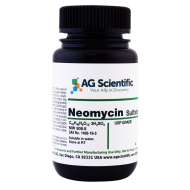Neomycins are a family of broad-spectrum highly toxic antibiotics produced by Streptomyces fradiae. Neomycin usually exists as a complex composed of two stereoisomers, neomycin B and neomycin C, which are the two active components. A third component, neomycin A, which is a degradation product, is present in small quantities.
Neomycins are a family of broad-spectrum highly toxic antibiotics produced by Streptomyces fradiae. Neomycin usually exists as a complex composed of two stereoisomers, neomycin B and neomycin C, which are the two active components. A third component, neomycin A, which is a degradation product, is present in small quantities. Neomycin C was isolated by DUTCHER et al. Neomycin C is composed of two molecules of neosamine C (2,6-diamino-2,6-dideoxy-Dglucopyranose)6), 2-deoxystreptamine7), and Dribose.- Neomycin C is used as an antibiotic selection marker.
- Neomycin is also used in milk replacers in combination with oxytetracycline to control and prevent diseases in cattle.
- In vitro studies have indicated that neomycin C is 50% as active as neomycin B against Staphylococcus epidermidis.
 Neomycin inhibits the initiation of protein biosynthesis by binding to the 30S ribosome, thereby blocking translation.
The real usefulness of neomycin as a tool in molecular biology came with the discovery of the mammalian antibiotic resistance gene (NeoR). This gene codes for an enzyme, aminoglycoside phosphotransferase, that catalyzes the phosphorylation of neomycin, gentamycin, and kanamycin, which inactivates them as inhibitors of protein synthesis. Expression of the NeoR gene, therefore, blocks the toxic effects of the aminoglycosides. Growth of transfected cells in the presence of neomycin allows for selection of cells that are expressing NeoR coupled to other genes of interest. NeoR and other drug-resistant genes are being considered for use in gene therapy to protect patients from the hematological side effects of chemotherapy. This new approach involves the use of a chimeric vector that fuses the antibiotic resistance genes with the genes of therapeutic value.
Ion Channels and Calcium
Neomycin inhibits the initiation of protein biosynthesis by binding to the 30S ribosome, thereby blocking translation.
The real usefulness of neomycin as a tool in molecular biology came with the discovery of the mammalian antibiotic resistance gene (NeoR). This gene codes for an enzyme, aminoglycoside phosphotransferase, that catalyzes the phosphorylation of neomycin, gentamycin, and kanamycin, which inactivates them as inhibitors of protein synthesis. Expression of the NeoR gene, therefore, blocks the toxic effects of the aminoglycosides. Growth of transfected cells in the presence of neomycin allows for selection of cells that are expressing NeoR coupled to other genes of interest. NeoR and other drug-resistant genes are being considered for use in gene therapy to protect patients from the hematological side effects of chemotherapy. This new approach involves the use of a chimeric vector that fuses the antibiotic resistance genes with the genes of therapeutic value.
Ion Channels and Calcium
 The specific interaction of neomycin with an ion channel has probably been most thoroughly studied with the skeletal muscle Ca -release channel, also known as RYR1. Neomycin has been suggested to inhibit the Ca -release channel by enhancing its rate of inactivation, and it appears to bind to a location in the carboxy-terminal 20% of the molecule. There may actually be multiple binding sites for neomycin on RYR1. Neomycin has been used as a tool to transfer a fluorescent label to its binding site on RYR1 to determine whether this region of the protein is involved in the conformational changes induced by various channel activators.
Neomycin is thought to mediate its effect through direct interaction with ion channels and continues to be used as a tool to study ion channel properties.
Its use as an inhibitor of ion channels and of the PI cycle has helped to elucidate the molecular events involved in these processes.
Food Industry
The specific interaction of neomycin with an ion channel has probably been most thoroughly studied with the skeletal muscle Ca -release channel, also known as RYR1. Neomycin has been suggested to inhibit the Ca -release channel by enhancing its rate of inactivation, and it appears to bind to a location in the carboxy-terminal 20% of the molecule. There may actually be multiple binding sites for neomycin on RYR1. Neomycin has been used as a tool to transfer a fluorescent label to its binding site on RYR1 to determine whether this region of the protein is involved in the conformational changes induced by various channel activators.
Neomycin is thought to mediate its effect through direct interaction with ion channels and continues to be used as a tool to study ion channel properties.
Its use as an inhibitor of ion channels and of the PI cycle has helped to elucidate the molecular events involved in these processes.
Food Industry
 Neomycin Sulfate is used for food testing in TSN agar to select for Clostridium perfringins and inhibit growth of Enterobacteria and Clostridium bifermentans in food industry.
The discovery of the antibiotic resistant genes has led to the widespread usage of neomycin and other aminoglycosides to select cells containing exogenous genes. The success of the neomycin selection technique in molecular biology and in the generation of transgenic mice has led to the possibility of using this approach in gene therapy.
References:
Enzymatic preparation of neomycin C from ribostamycin - Kudo F, Kawashima T, Yokoyama K, Eguchi T.
Rapid Technique for the Enumeration of Clostridium perfringens - Robert S. Marshall, J. Frank Steenbergen, and L. S. McClung
Neomycin - Wikipedia
Neomycin Sulfate is used for food testing in TSN agar to select for Clostridium perfringins and inhibit growth of Enterobacteria and Clostridium bifermentans in food industry.
The discovery of the antibiotic resistant genes has led to the widespread usage of neomycin and other aminoglycosides to select cells containing exogenous genes. The success of the neomycin selection technique in molecular biology and in the generation of transgenic mice has led to the possibility of using this approach in gene therapy.
References:
Enzymatic preparation of neomycin C from ribostamycin - Kudo F, Kawashima T, Yokoyama K, Eguchi T.
Rapid Technique for the Enumeration of Clostridium perfringens - Robert S. Marshall, J. Frank Steenbergen, and L. S. McClung
Neomycin - Wikipedia

